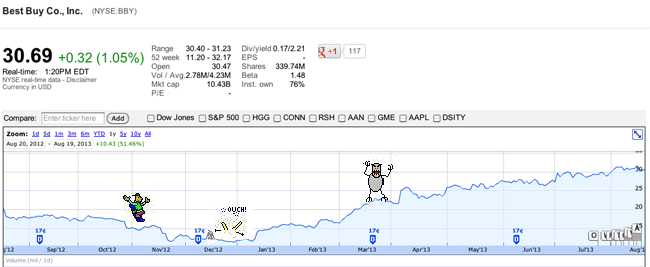After A Year On The Job, How’s Best Buy CEO Hubert Joly Doing?
 One year ago this week, Best Buy sought to end a turbulent year of executive shakeups, sinking sales, and all-around bad publicity, by naming Hubert Joly as the company’s new CEO. For a company whose previous CEO had worked his way from the retail floor to the boardroom, this was a huge departure, but was it a smart move?
One year ago this week, Best Buy sought to end a turbulent year of executive shakeups, sinking sales, and all-around bad publicity, by naming Hubert Joly as the company’s new CEO. For a company whose previous CEO had worked his way from the retail floor to the boardroom, this was a huge departure, but was it a smart move?
Just looking at the stock price, investors would probably say yes. Best Buy shares are currently trading at around $30 each, about $10/share more than what they were going for when Joly was handed the reins, and the highest value the company has seen since 2011. Of course, Best Buy’s stock also bottomed out at around $11 after the holidays, so Joly has taken the shareholders for a scary ride in the last 12 months.
Thomas Lee over at the Minneapolis Star-Tribune has looked back at Joly’s first year behind the CEO desk at Best Buy and graded him in a handful of different areas.
FINANCIAL PERFORMANCE
In 2011 and 2012, Best Buy went from earning a profit of $1.27 billion to taking a $1.23 billion loss, while sales at stores open more than one year dropped by 3.5%.
Since then, Best Buy has managed to get same store sales back up to a flat level — which is no mean feat in a retail industry quickly being taken over by online sellers. However, the store has had to cut its margins in order to compete with the likes of Amazon.
So while Joly’s efforts have helped stabilize sales, it remains to be seen if the company is making enough of a profit to sustain that level.
STRATEGY
The Joly regime has undone some of the offshoot businesses and international expansion plans put in place by previous Best Buy leadership, choosing to focus more on fixing the bricks-and-mortar stores and trying to make BestBuy.com competitive.
He’s also a firm believer in the store-within-a-store model, making deals with Samsung and Microsoft to set up branded sections on Best Buy sales floors.
“Wall Street loves it,” writes Lee. “Best Buy is predominantly a retailer so fixing the business that generates about 85 percent of annual revenues makes sense. But critics say the company still lacks a long-term vision.”
CULTURE
As sometimes happens at huge national retail chains, there is all sorts of money being tossed around on projects and ideas that never see the light of day, and should probably have never been considered in the first place. But Joly has tried to change that mindset at Best Buy HQ, reports Lee, by removing much of the free-for-all spending and adding personal accountability.
He’s further tightened the Best Buy belt by slashing hundreds of millions from the annual budget, which has resulted in hundreds of employees being let go over the last 12 months.
“Joly has also adopted the Net Promoter Score (NPS) to measure employee performance and customer satisfaction,” writes Lee. “Using NPS, Best Buy also wants to determine why a shopper left a store without buying something.”
Belt-tightening is difficult for a company the size of Best Buy to do correctly, and it still remains to be seen what the long-term results might mean for the consumer. Done properly, budgetary cuts and added accountability could result in a store that operates more efficiently and provides a meaningful response to the customer as employees will be deemed responsible for their actions.
Done improperly (which is too often the case), these same types of changes could lead to a company that makes the customer a secondary concern and leaves staffers without the proper resources to do their jobs. One need only look at Sears (and JCPenney’s recent struggles) to see what happens when a once-venerated retailer cuts costs without thought to the long-term impact on the customer.
In short, Joly has managed to get through the first year without further dragging Best Buy into the grave, though it’s far too soon to herald a renaissance for the retailer.
Want more consumer news? Visit our parent organization, Consumer Reports, for the latest on scams, recalls, and other consumer issues.

